
Feature Articles
(I) Food Safety Day
.jpg)
There is a Chinese saying that "food is people's paramount concern". When enjoying food, we should pay attention to food safety in order to prevent the spread of disease. Every summer, the Centre for Food Safety (CFS) organises a series of large-scale promotional activities to advocate food safety.
.jpg)
.jpg)
The theme of this year is "Five Keys to Food Safety". The campaign was kicked off by the "Food Safety Day 2008" jointly organised by CFS and Radio 1 of the Radio Television Hong Kong on 29 June 2008 at Tuen Mun Town Plaza. Mr. CHEUK Wing-hing, the Director of Food and Environmental Hygiene, officiated at the opening ceremony. Other officiating guests included Mr. CHEUNG Yu-yan, the Chairman of the Legislative Council Panel on Food Safety and Environmental Hygiene, Dr. CHAN Hon-yee, the Controller of the Centre for Food Safety, Mr. CHAN Yiu-wah, the Head of Radio 1 of the Radio Television Hong Kong, Professor KWAN Hoi-shan, the Chairman of the Expert Committee on Food Safety, Ms LAM Yuen-mui, the Acting Chief Executive of the Consumer Council, Mr. CHAN Wing-on, the Chairman of the Hong Kong Federation of Restaurants and Related Trades, Mr. YEUNG Wai-sing, the Chairman of the Association for Hong Kong Catering Services Management Ltd, Mr. WU Chu, the Vice-Chairman of the Hong Kong Catering Industry Association, Mr. Ronald LAU Yiu-fai, the President of the Hong Kong Food Council, and Mr. Albert CHAN, the Chairman of the Hong Kong Food & Science Technology Association.
"Five Keys to Food Safety" are "Choose" (choose safe raw materials), "Clean" (keep hands and utensils clean), "Separate" (separate raw and cooked food), "Cook" (cook thoroughly) and "Safe temperature" (keep food at safe temperature). Exhibition panels and game booths were set to help enhance people's awareness of the "Five Keys to Food Safety".
Artistes including Mr. Harry WONG, Ms. LAU Yuk-chui, Mr. Micheal CHENG, Ms. Fiona SIT, Ms. Kay TSE, Ms. Keeva MAK, Ms. Bianca WU, Ms. Ella KOON, Mr. CHAU Pak-ho, Ms. Stephanie CHENG, etc. were invited to give performances, such as magic shows, games and dramas, to promote the food safety message. The function was well received with more than 3,000 members of the public attending. About 18,000 publicity pamphlets and 5,000 souvenirs were distributed that day.
.jpg)
.jpg)
.jpg)
.jpg)
.jpg)
Press1.jpg)
II) Food Safety Charter
.jpg)
.jpg)
The Centre for Food Safety (CFS) has all along been promoting the importance of tripartite collaboration among the Government, the food trade and consumers to ensure that food sold in Hong Kong is safe and fit for human consumption. To highlight the theme of "Five Keys to Food Safety" this year, CFS has invited representatives of the food trade to sign the "Food Safety Charter". Upon signing the "Food Safety Charter", food trade associations and restaurants are committed to disseminating the messages of the "Five Keys to Food Safety" to their staff, members and customers, as well as to set a good example for the trade so as to uphold the food safety standard.

The "Food Safety Charter" signing ceremony was held on 3 July 2008. More than 70 representatives from food trade associations and licensed food premises who were members of the associations signed the "Food Safety Charter". The ceremony was witnessed by Mr CHEUK Wing-hing, the Director of Food and Environmental Hygiene, Mr CHEUNG Yu-yan, the Chairman of the Legislative Council Panel on Food Safety and Environmental Hygiene and Mr LI Wah-ming, the Deputy Chairman, Dr CHAN Hon-yee, the Controller of the Centre for Food Safety, Professor KWAN Hoi-shan, the Chairman of the Expert Committee on Food Safety and Mr Kenneth SO, the Head of Public Affairs Division of the Consumer Council. Addressing the ceremony, Mr CHEUK said that the trade had been playing a vital role in ensuring food safety by attending to every step of storage, processing and delivery of food from raw materials to end products. He thanked the trade for their enthusiastic support for the Charter and joining with the public and the Government in promoting and implementing measures to ensure food safety.
.jpg)
As at early September, a total of 20 food trade associations and more than 700 licensed food premises have signed the "Food Safety Charter".
All licensed food premises in the territory are encouraged to join the Government and consumers in promoting the "Five Keys to Food Safety" and building a food safe city.
CFS is now inviting licensed food premises to sign the "Food Safety Charter". For the application form and details of the activities, please visit the following web site of CFS:
http://www.cfs.gov.hk/english/whatsnew/whatsnew_fstr/whatsnew_fstr_food_safety_charter.html
.jpg)
Interested licensed food premises can send their completed application form by fax (fax number: 2787 3638) or mail to Communication Resource Unit, 8/F, Fa Yuen Street Municipal Services Building, 123A Fa Yuen Street, Mongkok, Kowloon.
For enquiries or application forms, please call 2381 6370.
(II) Pre-Statutory Voluntary Registration Scheme for Food Importers and Distributors
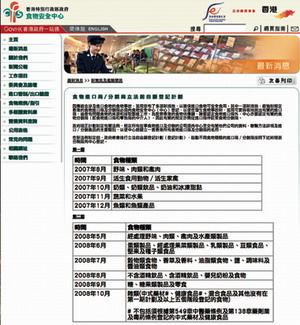
In response to a series of food incidents involving imported food, the Food and Health Bureau has announced a package of new measures to ensure the safety of imported food. One of these new initiatives is to introduce new legislation requiring all food importers and distributors to submit to CFS information including their company's particulars, contact details and the main food types which they import / distribute so that CFS can build up a register of food importers and distributors. In the event of a food incident, this will help CFS to more readily identify the importer(s) concerned, trace the source of the problematic food and take necessary actions.
Pending the enactment of the new legislation, CFS has launched a pre-statutory voluntary registration scheme to encourage importers / distributors of various food categories to register with CFS by phases. CFS also encourages the food trade to keep record of the movement of their food to enhance food traceability. Subject to the consent of the food business operators, CFS will upload to its web site the names of those companies registered under the Scheme for the reference of the local food trade and overseas food suppliers.
Further information about the Scheme can be found at the following web page:
http://www.cfs.gov.hk/english/whatsnew/whatsnew_fstr/whatsnew_fstr_pre_stat_vol_scheme.html
Readers' Corner
(I) Prepare Shrimp Sashimi with Care
Hong Kong people like delicious food and sashimi is one of the most popular foods in recent years. Due to a high market demand, sashimi is available not only in Japanese restaurants, but also in many other restaurants as well.
Sashimi is eaten raw and improper preparation can easily lead to food poisoning. The Food and Environmental Hygiene Department (FEHD) has imposed stringent licensing requirements for restaurants preparing and selling sashimi, and such restaurants must apply for a permit/endorsement from the Department.
Shrimp sashimi is a popular type of sashimi. During its preparation, the flesh of shrimps can be contaminated by pathogens like Vibrio parahaemolyticus and Vibrio cholera, attached to shrimp shells, causing sickness to the consumer. Therefore, restaurant licensees and food handlers should take precautionary measures by observing the "Five Keys to Food Safety."

Choose
- Imported raw materials for the preparation of sashimi should be accompanied by a copy of the health certificates issued by the relevant authority of the exporting country and acceptable to the Director of Food and Environmental Hygiene (FEHD). Restaurants should purchase from reliable and reputable sources.
Clean
- Preparation of sashimi should be conducted in a separate portion of a kitchen;
- Food handlers should wear clean uniform and maintain good personal hygiene. Any person who is suffering from discharging wound or sore on any part of the body or from attacks of diarrhoea or vomiting or from a sore throat or other communicable diseases should not take part in the handling of sashimi.
Separate
- Use exclusive chopping boards and cutlery for sashimi; clean and disinfect the utensils thoroughly before handling different types of sashimi. (For example: After preparing shrimp sashimi, clean and disinfect the utensils thoroughly before using them to prepare another type of sashimi);
- Shrimps to be used for preparing sashimi should be stored separately from other foods to prevent cross-contamination.
Cook
- Store chilled shrimps in refrigerators at a temperature between 0°C and 4°C, and frozen shrimps in freezers at a temperature below -18°C;
- Defrost sashimi at a temperature between 0°C and 4°C.
In addition, inform both the Department of Health and FEHD for follow-up action if any customer has gastrointestinal symptoms after consuming sashimi.
(II) Five Keys to Serve a Safe Buffet
To meet customers' demand, many restaurants serve buffets which offer a wide variety of foods including not only traditional cooked foods, but also high risk foods such as raw oyster and sashimi. In serving buffet, restaurants should be extra vigilant and follow the "Five Keys to Food Safety" to ensure food safety and prevent food poisoning.
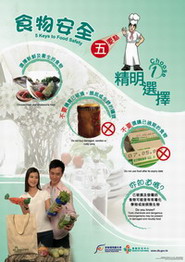
Choose
- Obtain fresh and wholesome foods and food ingredients from approved and reliable suppliers.
- Specify the delivery temperature to food suppliers (e.g. chilled food should be kept at 4°C or below) and check the quality of the ingredients upon receipt.
- Use safe raw materials (e.g. use pasteurized eggs to prepare Tiramisu)
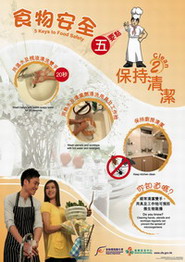
Clean
- Staff should practise good personal hygiene and handle food in a hygienic way.
- Wash hands thoroughly with warm soapy water before handling food.
- Cleanse utensils and worktops with hot water and detergent after each use.
- Staff should monitor the hygienic conditions of the food display area and remove any contaminated utensils and food immediately.
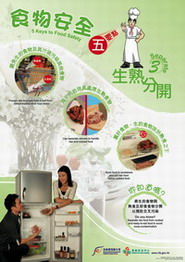
Separate
- Store raw and cooked or ready-to-eat foods separately.
- Use separate utensils (including knives and chopping boards) to handle raw and cooked or ready-to-eat foods.
- Display cooked and raw foods separately and provide customers with utensils in different styles (e.g. tongs in different colours or shapes) for picking these foods separately.
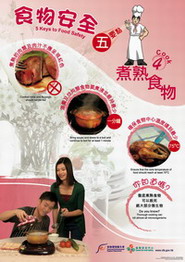
Cook
- Cook food thoroughly till the core temperature reaches 75 °C or above.
- When cooking meat and poultry, make sure that their juices are clear and not red; blood is not visible when you cut the cooked meat.
- Bring soups and stews to a boil and continue to boil for at least one minute.
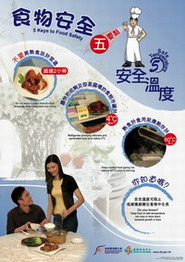
Safe Temperature
- Do not display food too early.
- Store cold dishes (e.g. raw oyster, sashimi and salad) in fridges or on ice at 4°C or below.
- Keep hot dishes in warming devices at 60°C or above.
- Display food in small portions to shorten display time; avoid placing food at room temperature for more than two hours.
- Avoid topping up a displayed batch of foods with a fresh one.
(III) Nitrate in Food

The media reported an incident that the skin of a nine-month-old baby boy turned blue after consumption of congee containing Chinese spinach. He was confirmed to suffer from Blue Baby Syndrome, i.e. methaemoglobinaemia, which is a rare condition under which haemoglobin in the blood has been oxidized to methaemoglobin and is unable to carry oxygen to the body tissues. Subsequent testing of the congee sample confirmed the presence of high nitrate content which could well be converted to nitrite in the baby boy causing the methaemoglobinaemia.
Nitrate occurs in the environment, in air, food (particularly in vegetables and fruits) and water, and is produced inside living organisms. It can also be used as preservatives, mainly in cheese products and cured meat (e.g. preserved sausage and ham). The level of nitrates in vegetables varies greatly among species. Higher levels of nitrate have been consistently reported in certain vegetables. However, the content of nitrate in food is generally safe for adult consumption.
Vegetables are important to human nutrition as a source of dietary fibre, vitamins and minerals and can help prevent the development of cancers and other chronic diseases. The public are advised to maintain a balanced diet and eat a variety of fruits and vegetables (i.e. leafy vegetables, fruiting vegetables, root vegetables, flowering/head brassicas etc. on different days) in order to avoid excessive exposure to chemicals from a small range of food.
Furthermore, babies below 6 months of age are most vulnerable to methaemoglobinaemia and should avoid vegetables of high nitrate content (e.g. spinach, beets) and processed food with nitrates added as food additives (e.g. cheese , cured meats).
Advice to the Trade
- Farmers are advised to observe good agricultural practice (e.g. proper use of fertiliser) with an aim to minimise nitrate concentrations in vegetables.
- Obtain food products from reliable sources.
- Follow the regulatory requirements regarding the use and labelling of food additives.
(IV) Watercress and Parasitic Infestation
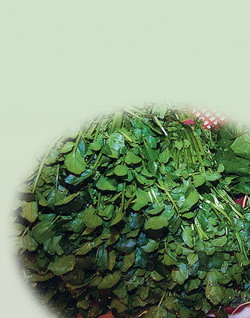
Recent newspapers reported that a local woman was infested by the parasitic liver fluke Fasciola after consuming raw watercress during her travel in Southeast Asia. Fascioliasis is an infection caused by Fasciola hepatica (the cattle/sheep liver fluke) or Fasciola gigantica. Humans are highly prone to infestation after eating uncooked water plants like watercress, which provide shelter for liver flukes. They can cause damage and enlargement of the liver during early stage of infestation, and can later cause severe pain in the right upper abdomen or yellowing of skin, and in some cases, skin inflammation. To prevent parasitic infestations, do not consume uncooked water plants, particularly watercress and water chestnuts.
Food News
Comparisons between Saturated Fat and Trans Fat
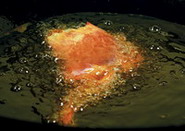
You probably have already known about saturated fat and its harmful effects on human health, particularly the risk of heart disease. In recent years, another type of fat, trans fat, has increasingly become a subject of concern both overseas and in Hong Kong . So what are the differences between these two types of fat? Which one is more damaging to our health? Please take a look at the following table and you will get the answers.


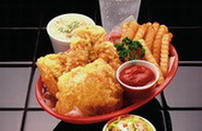
| Saturated Fat | Trans Fat | |
|---|---|---|
| Sources |
|
|
| Daily Intake Goal |
|
|
| Health Effects |
|
|
As part of a healthy diet, it is advisable to choose foods low in both trans fat and saturated fat.
Food Safety Plan Corner
Critical Control Points of Preparing Stir-fried Beef with Rice Noodles
What comes to mind at the mention of beef and rice noodles? Stir-fried beef with rice noodles, of course. This is a Hong Kong specialty dish on the menus of many restaurants, including fast food restaurants. Even though the dish is very popular, attention must be paid to some critical points on safety during its preparation. Heed these critical points on safety, and your customers can enjoy this delicious dish safely.
| Ingredients | |
|---|---|
| Rice noodles | 300 grams (about 8 taels) |
| Fresh Beef | 150 grams (about 4 taels) |
| Bean Sprouts | 50 grams |
| Blanching chive | 50 grams |
| Seasonings | |
|---|---|
| Oyster sauce | 2 tablespoons |
| Sesame oil | 1 teaspoon |
| Corn starch | 1 teaspoon |
| Dark soy sauce | 1 tablespoon |
| Light soy sauce | 1/2 tablespoon |
| Cooking oil | 2 tablespoons |
Steps:
- Slice the beef and marinate it with oyster sauce, sesame oil and corn starch for 15 minutes.
- Cut the blanching chives into several parts.
- After cooking the bean sprouts in boiling water, place them in a container to drain off the water.
- Pour 2 tablespoons of oil and put the marinated beef into the wok after preheating. When the beef is fully cooked by stir-frying, add rice noodles, blanching chives, bean sprouts, light soy sauce and dark soy sauce. Stir-fry evenly until they are thoroughly heated.
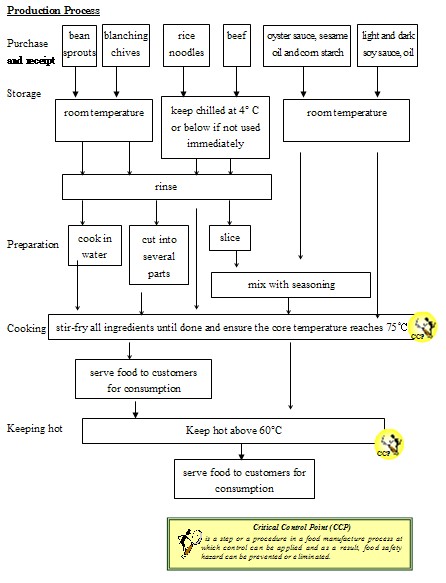
Safety Tips on Production of Stir-fried Beef with Rice Noodles
- Purchase
- Purchase the ingredients from reliable and hygienic suppliers.
- When buying and receiving the ingredients, make sure that
- the food is fresh and wholesome;
- the beef is purchased from a licensed "Fresh Provision Shop";
- all pre-packaged food items (e.g. oil and corn starch) are used before the expiry date.
- Storage
- Store the ingredients immediately at safe temperature.
- Raw beef and rice noodles not for immediate use should be stored in the refrigerator. The temperature inside the refrigerator should be checked regularly with a thermometer to ensure that the fridge remains at 4 oC or below.
- Raw beef should be stored in a container with a lid, and put under cooked food or ready-to-eat food to prevent cross contamination. Raw food and cooked food should most preferably be stored in different refrigerators.
- Practise the first-in-first-out principle for storage. Check and record the storage date of the ingredients.
- Store the ingredients immediately at safe temperature.
- Preparation
- Before cooking, wash all food contact surfaces (including worktops, chopping boards and cooking utensils) thoroughly.
- Before cooking / in the course of preparing food, wash hands thoroughly with warm water and liquid soap.
- Use two different sets of utensils (including knives, chopping boards, bowls and chopsticks) to handle raw and cooked food separately.
- Rinse rice noodles, beef, bean sprouts and blanching chives before cooking.
- Marinated beef not for immediate cooking should be stored in the refrigerator at 4 °C or below.
- Cooking
- Cook food thoroughly before consumption. The beef should be thoroughly cooked until the meat juice becomes clear and not red.
- Use a clean food thermometer to measure the core temperature of food, which should reach at least 75 oC.

- Keeping hot / Consumption
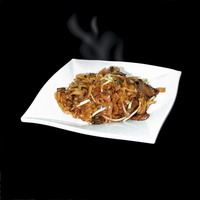 The cooked food should be served to customers for consumption as soon as possible. It should not be kept at room temperature for more than two hours.
The cooked food should be served to customers for consumption as soon as possible. It should not be kept at room temperature for more than two hours.- The food not for immediate consumption should be kept hot in a pre-heated plate or steamed pot above 60 oC.
- Management System
- A preventive food safety management system (such as the Hazard Analysis Critical Control Point) should be implemented to identify and control any food safety problems that may emerge during production.
Briefing of Activities
(I) Promoting "Five Keys to Food Safety" in Food Expo 2008
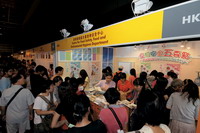
There are so many events not to be missed this summer! Besides the 2008 Olympic and Paralympic Equestrian Events hosted by Hong Kong, the Food Expo 2008 organised by the Hong Kong Trade Development Council from 14 to 18 August 2008 brought together food manufacturers and suppliers from Hong Kong, the Mainland and overseas countries, which offered a wide range of food and drinks to the public. To remind the public of food safety and hygiene while enjoying the great food, CFS set up a booth at the Expo to promote the "Five Keys to Food Safety" through games and exhibitions. Members of the public were advised to follow the "Five Keys to Food Safety" to ensure food safety.



(II) Workshop on Nutrition Labelling Scheme
Food and Drugs (Composition and Labelling) (Amendment: Requirements for Nutrition Labelling and Nutrition Claim) Regulation 2008 was enacted by the Legislative Council on 28 May and will come into effect on 1 July 2010.
In order to assist the trade and laboratory service providers to better understand and comply with the Nutrition Labelling Scheme, CFS has been conducting workshops on Nutrition Labelling Scheme for the trade since July. Our staff will introduce the Regulation and the Guidance Notes during the workshops and facilitate the participants to better understand the Regulation by case studies. Participants are also welcome to give their valuable opinions for our reference. For details of the workshops, please visit the following web site of CFS:
http://www.cfs.gov.hk/english/food_leg/food_leg_Workshop_on_Nutrition_Labelling_Scheme.html
Legal Corner
(I) Harmful Substances in Food Regulations

The Harmful Substances in Food Regulations (the "Regulations"), subsidiary legislation of the Public Health and Municipal Services Ordinance (Cap. 132), regulate harmful substances in food. The Regulations set out the maximum concentration of harmful substances in food and the substances prohibited for use in food. Any person who contravenes the Regulations is liable to a maximum fine of $50,000, imprisonment for 6 months and suspension of his food business licence.
The Regulations stipulate that the maximum permitted concentration of aflatoxin in peanut products and other food products are 20 and 15 micrograms per kilogram of the food respectively. Traces of aflatoxin may be found in food and long term intake may cause liver cancer.
In addition, the Regulations stipulate that clenbuterol is a prohibited substance. Selling pork and pig offal containing clenbuterol (a leanness-enhancing agent) is in breach of the Regulations. Consumption of clenbuterol tainted pig offal and pork may cause symptoms like dizziness, headache, hand tremor, palpitation and agitation. People with heart diseases are prone to more severe effects.
(II) Colouring Matter in Food (Amendment) Regulations 2008
Red 2G (also known as CI Food Red 10, International Numbering System No.128) is a synthetic dye which is resistant to heat, light, acids and sulphur dioxide. It imparts a light red colour, producing cherry to blood-red shades in foods. The European Food Safety Authority (EFSA) has recently re-evaluated the safety of Red 2G and concluded that the use of Red 2G in food would pose a safety concern.
Red 2G is converted into aniline in the human body and experts consider that aniline could possibly be carcinogenic. In the light of this, Hong Kong will ban the use of Red 2G as a colouring matter in food. The amended Colouring Matter in Food Regulations shall come into effect on 1 December 2008 .
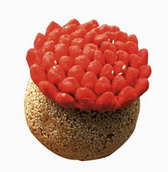
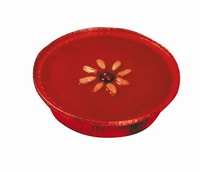
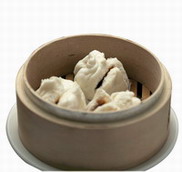
Advice to the Trade
- Stop using Red 2G and Red 2G containing colours.
- Reformulate the recipes by replacing Red 2G with permitted alternatives such as Erythrosine, Ponceau 4R, Amaranth, Allura Red AC or other natural permitted colours where appropriate.